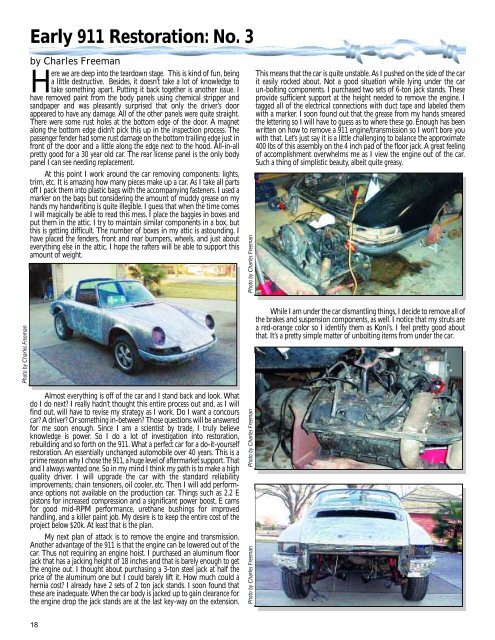Slipstream - November 2004
The monthly newsletter of the Maverick Region of the Porsche Club of America
The monthly newsletter of the Maverick Region of the Porsche Club of America
Create successful ePaper yourself
Turn your PDF publications into a flip-book with our unique Google optimized e-Paper software.
Early 911 Restoration: No. 3<br />
by Charles Freeman<br />
Here we are deep into the teardown stage. This is kind of fun, being<br />
a little destructive. Besides, it doesn’t take a lot of knowledge to<br />
take something apart. Putting it back together is another issue. I<br />
have removed paint from the body panels using chemical stripper and<br />
sandpaper and was pleasantly surprised that only the driver’s door<br />
appeared to have any damage. All of the other panels were quite straight.<br />
There were some rust holes at the bottom edge of the door. A magnet<br />
along the bottom edge didn’t pick this up in the inspection process. The<br />
passenger fender had some rust damage on the bottom trailing edge just in<br />
front of the door and a little along the edge next to the hood. All-in-all<br />
pretty good for a 30 year old car. The rear license panel is the only body<br />
panel I can see needing replacement.<br />
At this point I work around the car removing components: lights,<br />
trim, etc. It is amazing how many pieces make up a car. As I take all parts<br />
off I pack them into plastic bags with the accompanying fasteners. I used a<br />
marker on the bags but considering the amount of muddy grease on my<br />
hands my handwriting is quite illegible. I guess that when the time comes<br />
I will magically be able to read this mess. I place the baggies in boxes and<br />
put them in the attic. I try to maintain similar components in a box, but<br />
this is getting difficult. The number of boxes in my attic is astounding. I<br />
have placed the fenders, front and rear bumpers, wheels, and just about<br />
everything else in the attic. I hope the rafters will be able to support this<br />
amount of weight.<br />
Photo by Charles Freeman<br />
This means that the car is quite unstable. As I pushed on the side of the car<br />
it easily rocked about. Not a good situation while lying under the car<br />
un-bolting components. I purchased two sets of 6-ton jack stands. These<br />
provide sufficient support at the height needed to remove the engine. I<br />
tagged all of the electrical connections with duct tape and labeled them<br />
with a marker. I soon found out that the grease from my hands smeared<br />
the lettering so I will have to guess as to where these go. Enough has been<br />
written on how to remove a 911 engine/transmission so I won’t bore you<br />
with that. Let’s just say it is a little challenging to balance the approximate<br />
400 lbs of this assembly on the 4 inch pad of the floor jack. A great feeling<br />
of accomplishment overwhelms me as I view the engine out of the car.<br />
Such a thing of simplistic beauty, albeit quite greasy.<br />
Photo by Charles Freeman<br />
Almost everything is off of the car and I stand back and look. What<br />
do I do next? I really hadn’t thought this entire process out and, as I will<br />
find out, will have to revise my strategy as I work. Do I want a concours<br />
car? A driver? Or something in-between? Those questions will be answered<br />
for me soon enough. Since I am a scientist by trade, I truly believe<br />
knowledge is power. So I do a lot of investigation into restoration,<br />
rebuilding and so forth on the 911. What a perfect car for a do-it-yourself<br />
restoration. An essentially unchanged automobile over 40 years. This is a<br />
prime reason why I chose the 911, a huge level of aftermarket support. That<br />
and I always wanted one. So in my mind I think my path is to make a high<br />
quality driver. I will upgrade the car with the standard reliability<br />
improvements; chain tensioners, oil cooler, etc. Then I will add performance<br />
options not available on the production car. Things such as 2.2 E<br />
pistons for increased compression and a significant power boost, E cams<br />
for good mid-RPM performance, urethane bushings for improved<br />
handling, and a killer paint job. My desire is to keep the entire cost of the<br />
project below $20k. At least that is the plan.<br />
My next plan of attack is to remove the engine and transmission.<br />
Another advantage of the 911 is that the engine can be lowered out of the<br />
car. Thus not requiring an engine hoist. I purchased an aluminum floor<br />
jack that has a jacking height of 18 inches and that is barely enough to get<br />
the engine out. I thought about purchasing a 3-ton steel jack at half the<br />
price of the aluminum one but I could barely lift it. How much could a<br />
hernia cost? I already have 2 sets of 2 ton jack stands. I soon found that<br />
these are inadequate. When the car body is jacked up to gain clearance for<br />
the engine drop the jack stands are at the last key-way on the extension.<br />
Photo by Charles Freeman<br />
Photo by Charles Freeman<br />
While I am under the car dismantling things, I decide to remove all of<br />
the brakes and suspension components, as well. I notice that my struts are<br />
a red-orange color so I identify them as Koni’s. I feel pretty good about<br />
that. It’s a pretty simple matter of unbolting items from under the car.<br />
18


















